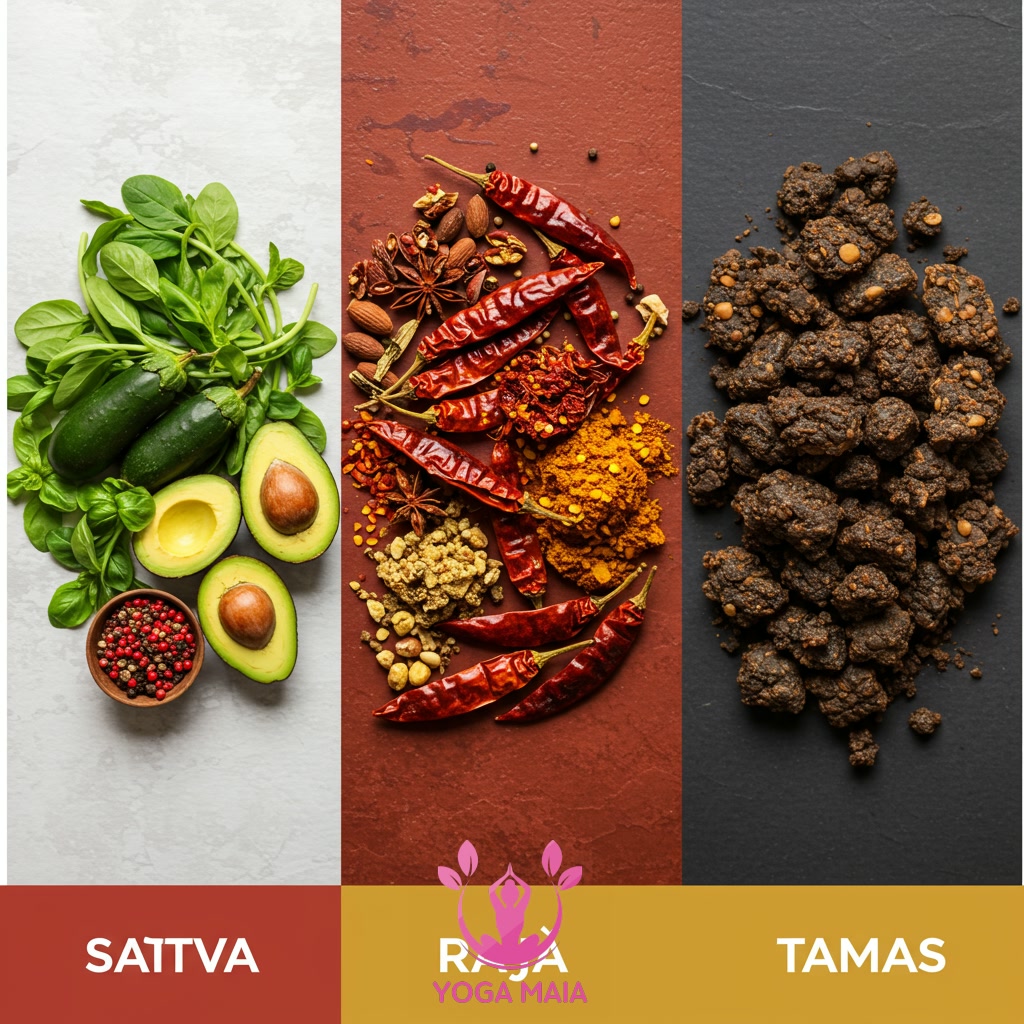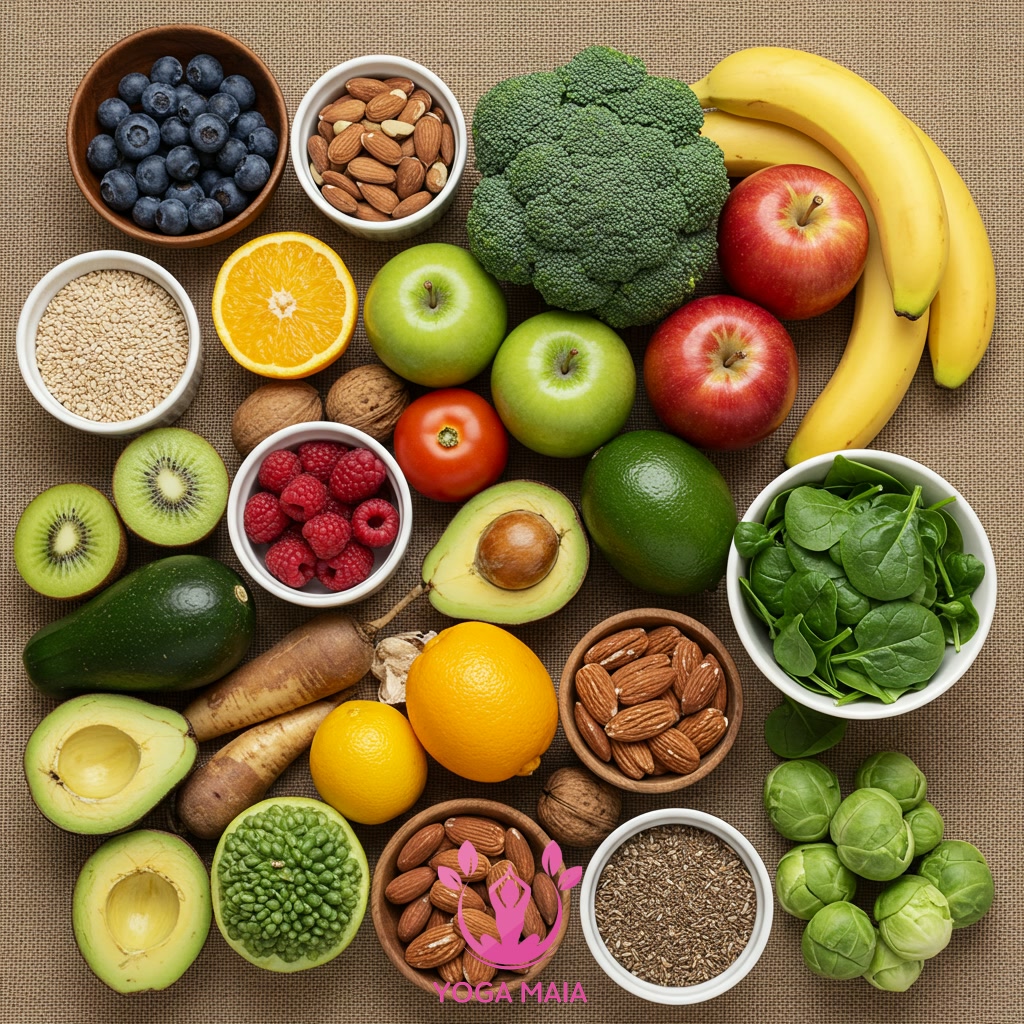Yoga Blog
Nourishing Your Practice: A Balanced Diet Guide for a Harmonious Yogic Lifestyle

This guide explores the crucial link between nutrition and a thriving yoga practice, offering practical advice for a balanced diet that supports a harmonious yogic lifestyle. It details how mindful eating can boost energy, enhance flexibility, and deepen your overall yoga experience. The content provides actionable steps to integrate nourishing foods into your routine, helping you cultivate inner and outer harmony. This resource empowers individuals to align their dietary choices with their commitment to yoga.
Table of Contents
- Section 1: The Symbiotic Relationship: Diet and Your Yoga Practice
- Section 2: Understanding Yogic Dietary Principles: Sattva, Rajas, and Tamas
- Section 3: Nourishing Your Body: Foods to Embrace for a Yogic Lifestyle
- Section 4: Avoiding Obstacles: Foods and Habits to Limit for Yogic Harmony
- Section 5: Practical Tips for Integrating Diet into Your Daily Yoga Routine
- Section 6: Beyond the Plate: Mindful Eating and Its Role in Yoga
- Section 7: Cultivating Well-being: The Long-Term Benefits of a Balanced Yogic Diet
Section 1: The Symbiotic Relationship: Diet and Your Yoga Practice
Yoga is far more than just the physical poses we practice on the mat; it is a holistic path towards well-being that encompasses mind, body, and spirit. A cornerstone of this holistic approach is mindful nourishment. The foods we consume directly impact our energy levels, mental clarity, and physical resilience, all of which are fundamental to a successful and fulfilling yoga practice. Just as the body requires proper alignment and breath control during asana, it also needs the right fuel to perform optimally, recover effectively, and maintain the mental focus necessary for meditation and introspection. Understanding this symbiotic relationship between what we eat and how we practice is the first step towards integrating diet as a powerful tool to enhance our yoga journey.
 The Symbiotic Relationship: Diet and Your Yoga Practice
The Symbiotic Relationship: Diet and Your Yoga Practice
Section 2: Understanding Yogic Dietary Principles: Sattva, Rajas, and Tamas
In yogic philosophy, the concept of the three ‘gunas’ or qualities – Sattva, Rajas, and Tamas – extends to the food we consume. Understanding these principles is key to aligning your diet with a harmonious practice. Sattvic foods are pure, fresh, light, and nourishing; they promote clarity, calmness, and energy, supporting a steady mind and body ideal for yoga and meditation. Rajasic foods are stimulating, spicy, or overly rich; they can increase restlessness, passion, and agitation, potentially disrupting focus. Tamasic foods are heavy, stale, processed, or overly dense; they lead to lethargy, dullness, and inertia, hindering physical and mental vitality. By consciously choosing predominantly Sattvic foods, you cultivate a state of being that naturally supports a deeper, more fulfilling yogic journey.
 Understanding Yogic Dietary Principles: Sattva, Rajas, and Tamas
Understanding Yogic Dietary Principles: Sattva, Rajas, and Tamas
Section 3: Nourishing Your Body: Foods to Embrace for a Yogic Lifestyle
Building upon the understanding of the gunas, a yogic lifestyle thrives on embracing foods that promote Sattva – qualities of purity, clarity, and lightness. These include fresh, organic fruits and vegetables, whole grains like rice and quinoa, legumes such as lentils and chickpeas, and nuts and seeds in their natural state. Fresh dairy products, used in moderation, and natural sweeteners like honey can also be part of this diet. Sattvic foods are typically easy to digest, providing sustained energy without weighing the body or mind down. Incorporating these vibrant, life-giving foods helps to cultivate a calm mind, a healthy body, and supports a more focused and harmonious yoga practice, aligning your physical nourishment with your spiritual path.
 Nourishing Your Body: Foods to Embrace for a Yogic Lifestyle
Nourishing Your Body: Foods to Embrace for a Yogic Lifestyle
Section 4: Avoiding Obstacles: Foods and Habits to Limit for Yogic Harmony
Building upon the understanding of foods that cultivate Sattva, it is equally important for a harmonious yogic lifestyle to be mindful of what can create imbalance or obstacles. Foods and habits that promote Rajas (activity, restlessness) and Tamas (inertia, dullness) should be limited. Rajasic foods often include excessive spice, deep-fried items, stimulants like strong coffee or tea, and overly processed snacks, which can lead to mental agitation and physical discomfort during practice. Tamasic foods, such as stale, heavy, or overly rich meals, excessive meat, alcohol, and processed convenience foods, can induce lethargy, cloud the mind, and reduce physical flexibility and energy. Avoiding or minimizing these can significantly support a clearer mind, a lighter body, and a deeper connection in your yoga practice.
 Avoiding Obstacles: Foods and Habits to Limit for Yogic Harmony
Avoiding Obstacles: Foods and Habits to Limit for Yogic Harmony
Section 5: Practical Tips for Integrating Diet into Your Daily Yoga Routine
Building on the understanding of foods that support balance and those that create obstacles, integrating these principles practically into your daily routine is key. A primary tip is timing: avoid heavy meals immediately before or after your yoga practice. Opt for light, easily digestible foods like fruits, nuts, or a small smoothie about 1-2 hours beforehand to provide energy without causing discomfort. After practice, wait at least 30 minutes before having a more substantial meal. Mindful eating is also crucial; pay attention to hunger cues, chew thoroughly, and savor your food, treating it as nourishment for both body and mind. Simple changes, like swapping processed snacks for fresh fruit or incorporating more legumes and vegetables into your meals, can significantly enhance your energy levels and overall well-being, supporting a consistent and harmonious practice.
 Practical Tips for Integrating Diet into Your Daily Yoga Routine
Practical Tips for Integrating Diet into Your Daily Yoga Routine
Section 6: Beyond the Plate: Mindful Eating and Its Role in Yoga
Building on the understanding of foods that support balance and those that create obstacles, integrating these principles practically into your daily routine is key. A primary tip is timing: avoid heavy meals immediately before practice. Beyond the timing and content of your meals lies a deeper connection: how you eat. Mindful eating is the practice of paying full attention to your food—its appearance, aroma, texture, and taste—and the experience of eating. It involves noticing your body’s hunger and fullness cues without judgment. This conscious approach to nourishment mirrors the principles of yoga, cultivating present moment awareness and a deeper connection to your physical self. By eating mindfully, you not only improve digestion and nutrient absorption but also reduce stress related to food, fostering a sense of peace and gratitude that directly supports your physical and mental state on and off the mat. It transforms eating from a mere task into a meditative act.
 Beyond the Plate: Mindful Eating and Its Role in Yoga
Beyond the Plate: Mindful Eating and Its Role in Yoga
Section 7: Cultivating Well-being: The Long-Term Benefits of a Balanced Yogic Diet
Beyond immediate improvements in energy and digestion, consistently adhering to a balanced yogic diet cultivates profound long-term well-being. Over time, this way of eating supports sustained vitality, reducing fatigue and enabling a more vigorous and consistent yoga practice. The emphasis on whole, pure foods aids in maintaining a healthy weight, enhancing flexibility, and promoting clearer skin and eyes, reflecting inner health. Mentally, it fosters greater clarity, focus, and emotional stability, making meditation and pranayama practices more accessible and effective. This sustained physical and mental harmony deepens one’s connection to their body and mind, leading to a more peaceful, joyful, and balanced existence that extends far beyond the mat.
 Cultivating Well-being: The Long-Term Benefits of a Balanced Yogic Diet
Cultivating Well-being: The Long-Term Benefits of a Balanced Yogic Diet












